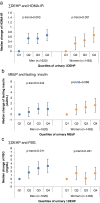Gender and racial/ethnic differences in the associations of urinary phthalate metabolites with markers of diabetes risk: National Health and Nutrition Examination Survey 2001-2008
- PMID: 24499162
- PMCID: PMC3922428
- DOI: 10.1186/1476-069X-13-6
Gender and racial/ethnic differences in the associations of urinary phthalate metabolites with markers of diabetes risk: National Health and Nutrition Examination Survey 2001-2008
Abstract
Background: Phthalates are ubiquitous endocrine disrupting chemicals associated with diabetes. Although women and minorities are more likely to be exposed to phthalates, no prior studies have examined phthalate exposure and markers of diabetes risk evaluating effect modification by gender and race/ethnicity.
Methods: We analyzed CDC data for 8 urinary phthalate metabolites from 3,083 non-diabetic, non-pregnant participants aged 12- < 80 years in the National Health and Nutrition Examination Survey (NHANES) 2001-2008. We used median regression to assess the associations between urinary phthalate metabolites and fasting blood glucose (FBG), fasting insulin and Homeostatic Model Assessment of insulin resistance (HOMA-IR), controlling for urinary creatinine as well as several sociodemographic and behavioral factors. Stratified analyses were conducted to compare the gender- and race/ethnicity-specific patterns for the associations.
Results: Urinary levels of several phthalate metabolites, including MBzP, MnBP, MiBP, MCPP and ∑DEHP showed significant positive associations with FBG, fasting insulin and HOMA-IR. No clear difference was noted between men and women. Mexican-Americans and non-Hispanic blacks had stronger dose-response relationships for MnBP, MiBP, MCPP and ∑DEHP compared to non-Hispanic whites. For example, the highest quartile of MiBP relative to its lowest quartile showed a median FBG increase of 5.82 mg/dL (95% CI: 3.77, 7.87) in Mexican-Americans, 3.63 mg/dL (95% CI: 1.23, 6.03) in blacks and 1.79 mg/dL (95% CI: -0.29, 3.87) in whites.
Conclusions: The findings suggest that certain populations may be more vulnerable to phthalates with respect to disturbances in glucose homeostasis. Whether endocrine disrupting chemicals contribute to gender and racial/ethnic differences in diabetes risk will be an important area for further study.
Figures


Similar articles
-
Urinary phthalate metabolite concentrations and diabetes among women in the National Health and Nutrition Examination Survey (NHANES) 2001-2008.Environ Health Perspect. 2012 Sep;120(9):1307-13. doi: 10.1289/ehp.1104717. Epub 2012 Jul 13. Environ Health Perspect. 2012. PMID: 22796563 Free PMC article.
-
Urinary phthalate metabolites and metabolic syndrome in U.S. adolescents: Cross-sectional results from the National Health and Nutrition Examination Survey (2003-2014) data.Int J Hyg Environ Health. 2019 Mar;222(2):195-204. doi: 10.1016/j.ijheh.2018.09.005. Epub 2018 Oct 5. Int J Hyg Environ Health. 2019. PMID: 30297147 Free PMC article.
-
Association of Urinary Phthalate Metabolites With Erectile Dysfunction in Racial and Ethnic Groups in the National Health and Nutrition Examination Survey 2001-2004.Am J Mens Health. 2017 May;11(3):576-584. doi: 10.1177/1557988316641370. Epub 2016 Apr 1. Am J Mens Health. 2017. PMID: 27036411 Free PMC article.
-
Phthalate exposure and risk of diabetes mellitus: Implications from a systematic review and meta-analysis.Environ Res. 2022 Mar;204(Pt B):112109. doi: 10.1016/j.envres.2021.112109. Epub 2021 Sep 23. Environ Res. 2022. PMID: 34562484
-
Racial/Ethnic Differences in Glycemic Control in Older Adults with Type 2 Diabetes: United States 2003-2014.Int J Environ Res Public Health. 2020 Feb 4;17(3):950. doi: 10.3390/ijerph17030950. Int J Environ Res Public Health. 2020. PMID: 32033032 Free PMC article. Review.
Cited by
-
Phthalate mixtures and insulin resistance: an item response theory approach to quantify exposure burden to phthalate mixtures.J Expo Sci Environ Epidemiol. 2024 Jul;34(4):581-590. doi: 10.1038/s41370-023-00535-z. Epub 2023 Mar 25. J Expo Sci Environ Epidemiol. 2024. PMID: 36966251 Free PMC article.
-
Protective effects of polyphenols against endocrine disrupting chemicals.Food Sci Biotechnol. 2022 Jul 12;31(8):905-934. doi: 10.1007/s10068-022-01105-z. eCollection 2022 Jul. Food Sci Biotechnol. 2022. PMID: 35873371 Free PMC article. Review.
-
Prevalence and predictors of phthalate exposure in pregnant women in Charleston, SC.Chemosphere. 2018 Feb;193:394-402. doi: 10.1016/j.chemosphere.2017.11.019. Epub 2017 Nov 8. Chemosphere. 2018. PMID: 29154114 Free PMC article.
-
Asking Why Is Necessary to Address Health Disparities: A Critical Approach for Solution-Oriented Environmental Epidemiological Research.Environ Health Perspect. 2024 Nov;132(11):115001. doi: 10.1289/EHP14513. Epub 2024 Nov 14. Environ Health Perspect. 2024. PMID: 39541091 Free PMC article.
-
Risk perception and use of personal care products by race and ethnicity among a diverse population.UCL Open Environ. 2024 May 13;6:e3038. doi: 10.14324/111.444/ucloe.3038. eCollection 2024. UCL Open Environ. 2024. PMID: 38757092 Free PMC article.
References
MeSH terms
Substances
Grants and funding
LinkOut - more resources
Full Text Sources
Other Literature Sources
Medical
Molecular Biology Databases

